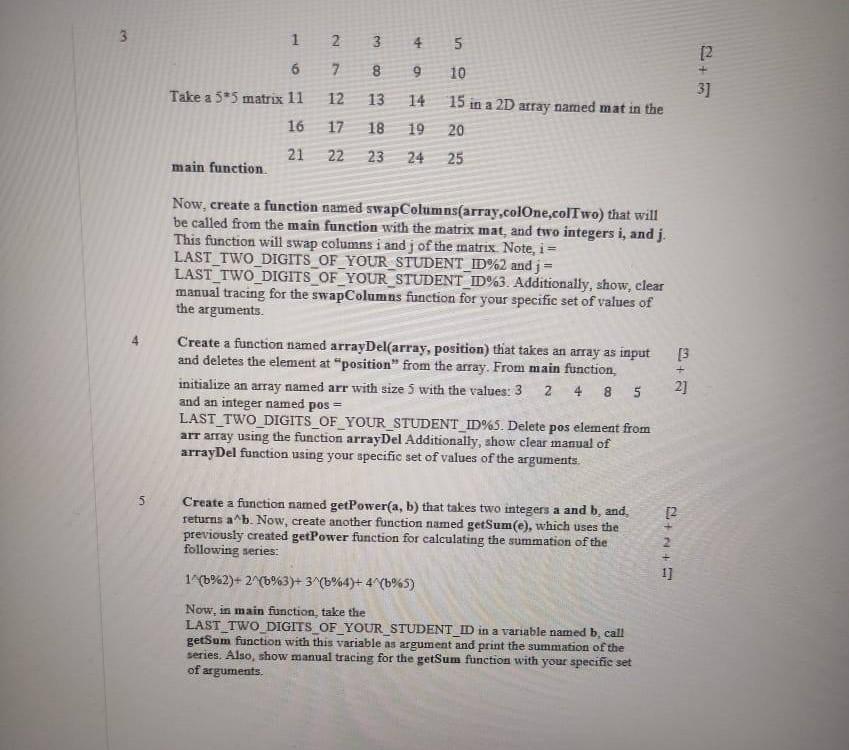
3 3 1 N 3 4 5 5 [2 6 7 8 Take a 5*5 matrix 11 12 3] 13 9 10 14 15 in a 2D array named mat in the 20 24 25 16 17 18 19 21 22 23 main function Now, create a function named swap Columns(array,colone,colTwo) that will be called from the main function with the matrix mat, and two integers i, and j. This function will swap columns i and j of the matrix. Note, i = LAST_TWO DIGITS_OF_YOUR_STUDENT_ID%2 and j = LAST TWO DIGITS_OF_YOUR_STUDENT_ID%3. Additionally, show, clear manual tracing for the swapColumns function for your specific set of values of the arguments. Create a function named arrayDel(array, position) that takes an array as input 3 and deletes the element at "position from the array. From main function, 2] initialize an array named arr with size 5 with the values: 3 2 4 8 5 and an integer named pos = LAST TWO DIGITS_OF_YOUR_STUDENT_ID%5. Delete pos element from arr array using the function arrayDel Additionally, show clear manual of arrayDel function using your specific set of values of the arguments + 5 [2 Create a function named getPower(a, b) that takes two integers a and b, and. returns a^b. Now, create another function named getSum(e), which uses the previously created getPower function for calculating the summation of the following series: 14(b%2)+2 (6%3)+3/(b%4)+ 4^(b%5) 2 1] Now, in main function, take the LAST_TWO DIGITS_OF_YOUR_STUDENT_ID in a variable named b, call getSum function with this variable as argument and print the summation of the series. Also, show manual tracing for the getSum function with your specific set of arguments. 3 3 1 N 3 4 5 5 [2 6 7 8 Take a 5*5 matrix 11 12 3] 13 9 10 14 15 in a 2D array named mat in the 20 24 25 16 17 18 19 21 22 23 main function Now, create a function named swap Columns(array,colone,colTwo) that will be called from the main function with the matrix mat, and two integers i, and j. This function will swap columns i and j of the matrix. Note, i = LAST_TWO DIGITS_OF_YOUR_STUDENT_ID%2 and j = LAST TWO DIGITS_OF_YOUR_STUDENT_ID%3. Additionally, show, clear manual tracing for the swapColumns function for your specific set of values of the arguments. Create a function named arrayDel(array, position) that takes an array as input 3 and deletes the element at "position from the array. From main function, 2] initialize an array named arr with size 5 with the values: 3 2 4 8 5 and an integer named pos = LAST TWO DIGITS_OF_YOUR_STUDENT_ID%5. Delete pos element from arr array using the function arrayDel Additionally, show clear manual of arrayDel function using your specific set of values of the arguments + 5 [2 Create a function named getPower(a, b) that takes two integers a and b, and. returns a^b. Now, create another function named getSum(e), which uses the previously created getPower function for calculating the summation of the following series: 14(b%2)+2 (6%3)+3/(b%4)+ 4^(b%5) 2 1] Now, in main function, take the LAST_TWO DIGITS_OF_YOUR_STUDENT_ID in a variable named b, call getSum function with this variable as argument and print the summation of the series. Also, show manual tracing for the getSum function with your specific set of arguments







